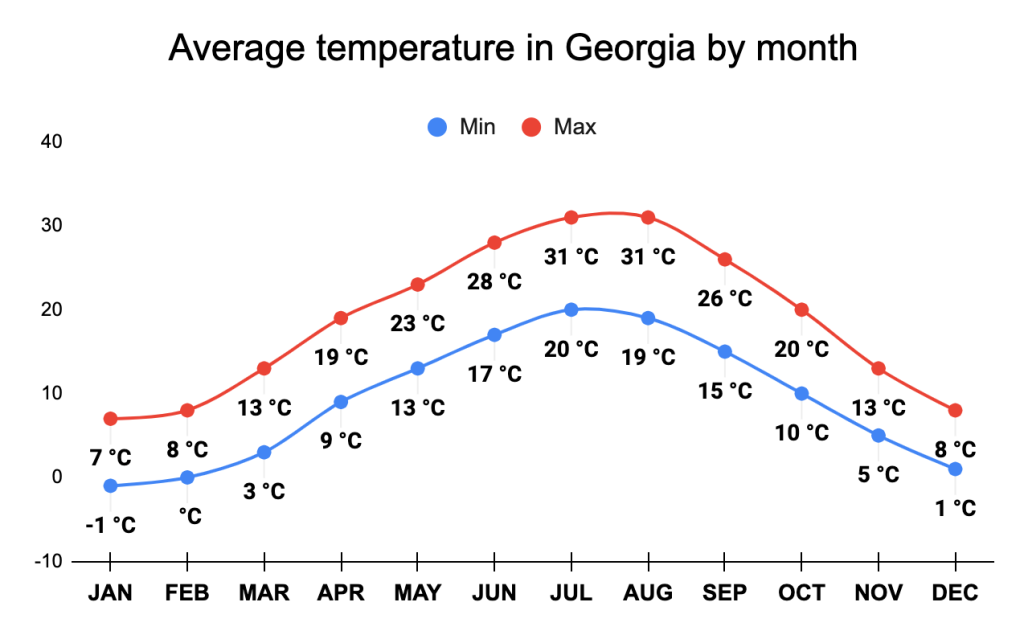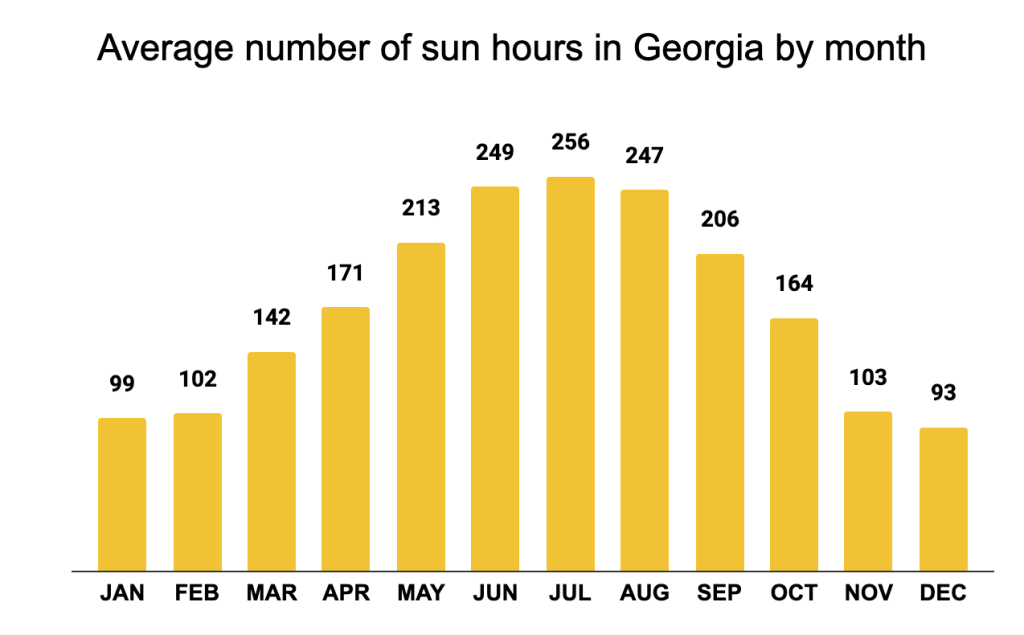Are you planning a trip to Georgia and wondering when the ideal time to visit is?
If you’re looking to experience the best weather and fully enjoy all that this beautiful country has to offer, the best time to visit Georgia is generally from April to October.
During these months, the temperatures are warm and comfortable, making it the perfect time to explore Georgia’s stunning beaches, mountains, and historic cities.
In this guide, we’ll provide a detailed look at the best times to visit Georgia based on your specific travel interests and preferences.
About Georgia
Georgia is a country in the Caucasus region of Europe, located between the Black Sea and the Caspian Sea. It is bordered by Russia to the north, Azerbaijan to the east, Armenia to the south, and Turkey to the west.
Georgia has a rich and diverse culture, with influences from its history as part of the Soviet Union, as well as its location at the crossroads of Europe and Asia. It has a population of about 3.7 million people, and the official language is Georgian.
The country is known for its beautiful landscapes, including the Caucasus Mountains, which run through the country and are home to many national parks and natural reserves.
Georgia is also home to a number of ancient cultural and historical sites, including the city of Tbilisi, which is the country’s capital and largest city, and the ancient city of Mtskheta, which is a UNESCO World Heritage Site.
Climate in Georgia
Georgia has a varied climate due to its diverse topography and its location at the crossroads of Europe and Asia.
The country has a humid Subtropical Climate in the low-lying areas, with hot, humid summers and mild winters.
In the higher elevations of the Caucasus Mountains, the climate becomes more Continental, with colder winters and cooler summers.
Average temperature
Georgia has a diverse climate, with temperatures ranging from hot to cold throughout the year.
The summer months of June, July, and August are the hottest, with average high temperatures of 28-31 degrees Celsius (82-88 degrees Fahrenheit) and relatively mild minimum temperatures of 17-20 degrees Celsius (63-68 degrees Fahrenheit).
The spring months of March, April, and May are cooler, with average high temperatures of 13-23 degrees Celsius (55-73 degrees Fahrenheit) and minimum temperatures ranging from 3-13 degrees Celsius (37-55 degrees Fahrenheit).
The fall months of September, October, and November are also pleasant, with average high temperatures of 13-26 degrees Celsius (55-79 degrees Fahrenheit) and minimum temperatures of 5-15 degrees Celsius (41-59 degrees Fahrenheit).
The winter months of December, January, and February are the coldest, with average high temperatures of 7-8 degrees Celsius (45-46 degrees Fahrenheit) and minimum temperatures that can drop below freezing, averaging at -1 to 1 degrees Celsius (30-34 degrees Fahrenheit).

Number of monthly rainy days
Georgia experiences the most rainy days during the spring and early summer, with a slightly lower number of rainy days during the late summer and fall.
The rainiest months in Georgia are May and June, with an average of 10 and 12 rainy days, respectively.

Number of monthly sun hours
Georgia experiences the most sun hours during the late spring and summer, with a lower number of sun hours during the winter and fall.
The lowest number of monthly sun hours in Georgia are in late fall (November) and in winter (December-February).
The number of sun hours increases significantly in the spring, with 142 sun hours in March, and 171 sun hours in April.
The sunniest months in Georgia are May, June, July, and August, with 213, 249, 256, and 247 sun hours, respectively.
The number of sun hours decreases slightly in the fall, with 206 sun hours in September, and 164 sun hours in October.

Seasons in Georgia
Georgia, like most countries in the Northern Hemisphere, has four seasons: winter, spring, summer, and fall.
Spring (March to May)

Spring in Georgia lasts from March to May. During this time Georgia experiences mild to warm temperatures and increasing amounts of sunshine.
The maximum temperature in March is around 13 degrees Celsius (55 degrees Fahrenheit), increasing to 19 degrees Celsius (66 degrees Fahrenheit) in April and 23 degrees Celsius (74 degrees Fahrenheit) in May.
The minimum temperature is also relatively mild, starting at 3 degrees Celsius (38 degrees Fahrenheit) in March, increasing to 9 degrees Celsius (47 degrees Fahrenheit) in April, and reaching 13 degrees Celsius (55 degrees Fahrenheit) in May.
In terms of sunshine, Georgia experiences 142 hours of sun in March, 171 hours in April, and 213 hours in May.
The number of rainy days also increases slightly during the spring, with an average of 6 rainy days in March, 8 rainy days in April, and 10 rainy days in May.
Overall, the weather in spring in Georgia is generally pleasant and allows for a variety of outdoor activities.
| SPRING | MAR | APR | MAY |
|---|---|---|---|
| Max temperature | 13°C / 55°F | 19°C / 66°F | 23°C / 74°F |
| Min temperature | 3°C / 38°F | 9°C / 47°F | 13°C / 55°F |
| Monthly sun hours | 142 hours | 171 hours | 213 hours |
| Monthly rainy days | 6 days | 8 days | 10 days |
| Weather conditions | Tolerable | Good | Great |
Summer (June to August)

Summer in Georgia lasts from June to August. It’s characterized by warm to hot temperatures and long daylight hours.
The maximum temperature in June is around 28 degrees Celsius (83 degrees Fahrenheit), increasing to 31 degrees Celsius (88 degrees Fahrenheit) in July and August.
The minimum temperature is also relatively mild, starting at 17 degrees Celsius (62 degrees Fahrenheit) in June, increasing to 20 degrees Celsius (68 degrees Fahrenheit) in July, and reaching 19 degrees Celsius (67 degrees Fahrenheit) in August.
In terms of sunshine, Georgia experiences 249 hours of sun in June, 256 hours in July, and 247 hours in August.
The number of rainy days also decreases slightly during the summer, with an average of 12 rainy days in June, 10 rainy days in July, and 7 rainy days in August.
Overall, the weather conditions in Georgia during the summer are great, making it a popular time for outdoor activities such as swimming and hiking.
| SUMMER | JUN | JUL | AUG |
|---|---|---|---|
| Max temperature | 28°C / 83°F | 31°C / 88°F | 31°C / 88°F |
| Min temperature | 17°C / 62°F | 20°C / 68°F | 19°C / 67°F |
| Monthly sun hours | 249 hours | 256 hours | 247 hours |
| Monthly rainy days | 12 days | 10 days | 7 days |
| Weather conditions | Great | Great | Great |
Autumn (September to November)

Fall in Georgia lasts from September to November. It’s characterized by cooler temperatures and decreasing amounts of sunshine.
The maximum temperature in September is around 26 degrees Celsius (79 degrees Fahrenheit), decreasing to 20 degrees Celsius (68 degrees Fahrenheit) in October and 13 degrees Celsius (55 degrees Fahrenheit) in November.
The minimum temperature also decreases during this time, starting at 15 degrees Celsius (59 degrees Fahrenheit) in September, decreasing to 10 degrees Celsius (51 degrees Fahrenheit) in October, and reaching 5 degrees Celsius (41 degrees Fahrenheit) in November.
In terms of sunshine, Georgia experiences 206 hours of sun in September, 164 hours in October, and 103 hours in November.
The number of rainy days also increases slightly during the autumn, with an average of 8 rainy days in September, 9 rainy days in October, and 10 rainy days in November.
| AUTUMN | SEP | OCT | NOV |
|---|---|---|---|
| Max temperature | 26°C / 79°F | 20°C / 68°F | 13°C / 55°F |
| Min temperature | 15°C / 59°F | 10°C / 51°F | 5°C / 41°F |
| Monthly sun hours | 206 hours | 164 hours | 103 hours |
| Monthly rainy days | 8 days | 9 days | 10 days |
| Weather conditions | Great | Good | Tolerable |
Winter (December to February)

Winter in Georgia lasts from December to February. It’s characterized by cold temperatures and relatively low amounts of sunshine. Snow is not uncommon in some parts of the country during this time.
The maximum temperature in December is around 8 degrees Celsius (46 degrees Fahrenheit), remaining relatively stable at 7 degrees Celsius (44 degrees Fahrenheit) in January and 8 degrees Celsius (46 degrees Fahrenheit) in February.
The minimum temperature during this time is also quite cold, starting at 1 degree Celsius (35 degrees Fahrenheit) in December, dropping to -1 degree Celsius (31 degrees Fahrenheit) in January, and reaching 0 degrees Celsius (32 degrees Fahrenheit) in February.
In terms of sunshine, Georgia experiences 93 hours of sun in December, 99 hours in January, and 102 hours in February.
The number of rainy days is relatively low during the winter, with an average of 4 rainy days in December, 4 rainy days in January, and 5 rainy days in February.
Overall, the weather conditions in Georgia during the winter are generally bad, with cold temperatures and relatively low amounts of sunshine.
| WINTER | DEC | JAN | FEB |
|---|---|---|---|
| Max temperature | 8°C / 46°F | 7°C / 44°F | 8°C / 46°F |
| Min temperature | 1°C / 35°F | -1°C / 31°F | 0°C / 32°F |
| Monthly sun hours | 93 hours | 99 hours | 102 hours |
| Monthly rainy days | 4 days | 4 days | 5 days |
| Weather conditions | Bad | Bad | Bad |
Best time to visit Georgia weather-wise
In general, the best time to visit Georgia weather-wise is from April to October. This is when the temperatures are warm and comfortable, making it a great time to explore the country.
In the lowland regions, such as the capital city of Tbilisi, the weather is humid subtropical, with hot and humid summers and mild winters. If you want to experience the city, the best time to visit is from April to October.
If you want to visit the mountainous regions of Georgia, such as the Caucasus Mountains, the best time to visit is from June to August, when the weather is cooler and drier. This is a great time to go hiking, climbing, and enjoy other outdoor activities in the mountains.
Best time to visit Georgia for sightseeing

The best time to visit Georgia for sightseeing is from April to October when the weather is warm and dry.
This is a great time to visit the capital city of Tbilisi and other major cities, such as Batumi and Kutaisi, and explore the country’s rich cultural and historical heritage.
See other destinations in Europe






